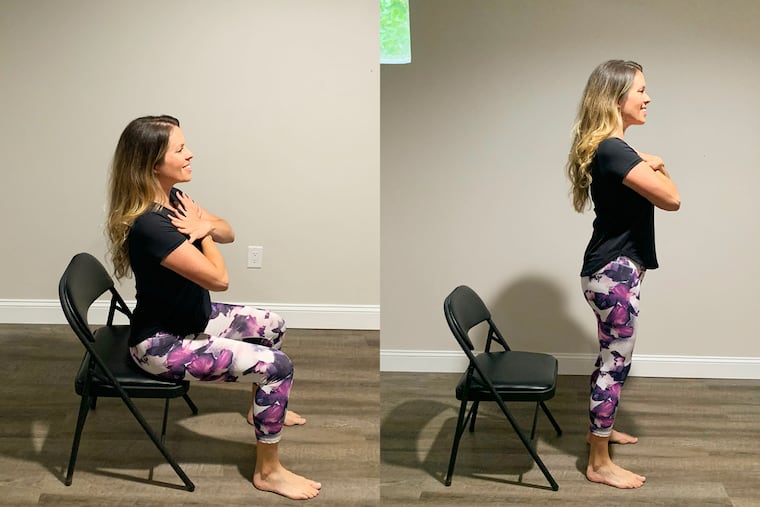Are you at an increased risk for falls? Take this test to find out.
For those age 60 and older, there is one fitness test in particular that’s truly worth trying: the 30-second chair stand test.

There are a number of fitness tests geared toward assessing physical competence, strength, and overall well-being. For those age 60 and older, there is one evaluation, in particular, that’s truly worth trying: the 30-second chair stand test.
This quick fitness trial focuses on how well you can smoothly and continually shift back and forth between sitting and standing. While this may not sound like a challenge, this two-step sequence can indicate whether you are at an increased risk for falls because it measures the aptitude of the muscles responsible for balance and stability.
These physical abilities are essential in preserving your safety, independence, and quality of life. And because aging can cause muscle mass to atrophy and bones to become brittle, it’s especially valuable to be aware of this danger.
You will need a stopwatch and an armless chair for this test. To make it easier, recruit a friend who can record time and results, as well as keep an eye on your form. Here’s how the 30-second chair stand test works:
Step 1: Sit in the middle of your chair with your arms crossed over your chest and feet firmly planted on the floor. Your knees should be bent at a 90-degree angle, legs parallel, and toes facing forward.
Step 2: Set the stopwatch for 30 seconds. When your partner says “Go” begin the sit-to-stand sequence. Count how many times you can successfully move from a sitting to a full standing position. If you use your upper body for momentum — such as pushing off your thighs or swinging your arms — stop the watch and record a zero.
Compare your results to the table of below average scores, which indicates an increased risk for falls.
If your total number fell below the ideal score, there’s no need to panic. Instead, use this information as motivation to start strengthening your core and lower-body muscles.
Practicing preventive exercises is the key to protecting and preserving your body. Here are tried-and-true toning techniques to help improve glute, hamstring, quad, and calf strength. For some of these exercises you will need a mini exercise ball, which can be purchased for less than $10 on Amazon. A well-cushioned pillow can be used, as well.
Squats. Perhaps the most obvious exercise to improve lower-body strength is the squat. After all, that is what the body is doing when it moves from a sit-to-stand position.
If you suffer from sore knees, squats can be scary. But when done properly, this highly effective exercise should be painless. To squat safely, start by sitting at the edge of your seat with your arms crossed over your chest. Just like the above test, push through your heels to stand, then carefully lower back down. Practice this eight times. Once that feels easy, make it more challenging by adding reps or holding a set of free weights in your hands. When you nail that, it’s time to remove the chair and try an unassisted squat.
Hip helpers. The abductor and adductor muscles are located on the outside of the hip and inner thighs. They play an important role in supporting, stabilizing, and rotating the leg. Here are two exercises that target these pivotal points in the body:
Clamshells:
Begin on your side with your legs stacked, knees bent, and head resting on your hand.
Slowly pull your upper knee away from your lower knee. Squeeze at your hip for two counts, then slowly return your leg back down, leaving a small bit of space between your legs to make them work harder. Repeat 12 to 15 times, then switch sides.
Mini exercise ball/pillow glute bridge:
Start on your back with your knees bent and feet firmly planted on the floor. Place the ball or pillow between your knees and squeeze so you feel tension in your inner thighs. Extend your arms to the sides for support.
Push through your heels to lift your hips until they form a straight line from shoulders to knees. Hold for two counts, then lower your hips back toward the floor without coming all the way down. Repeat 20 times.
Lunges. Lunges are another exercise that evokes fear due to knee pain concerns. For this single-sided skill to be performed safely, it’s all about joint alignment and moving slowly with each repetition.
Start by standing next to a chair for support, but do not hang on to it unless necessary. Your shoulders should be stacked above hips, hips over ankles, and toes facing forward.
Without shifting your form, take a step back with your right foot and lower your body until both knees are at a 90-degree angle. All of your body weight should remain in your front heel. Do not allow your front knee to extend past your toes. Hold for two counts then push through your front heel to stand. Perform six times, then switch sides.
Ashley Blake Greenblatt is a certified personal trainer and wellness coach in South Jersey. To learn more about her virtual training program, go to ashleyblakefitness.com.